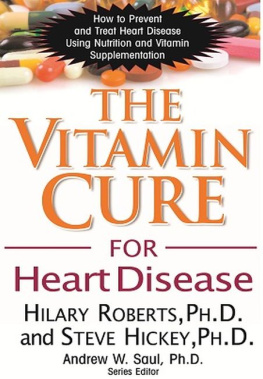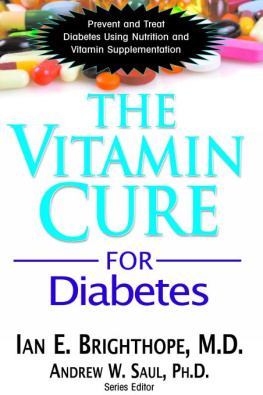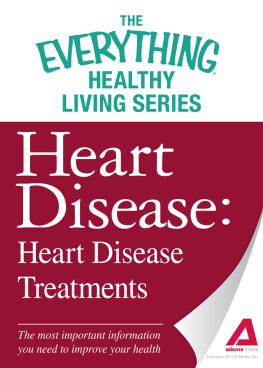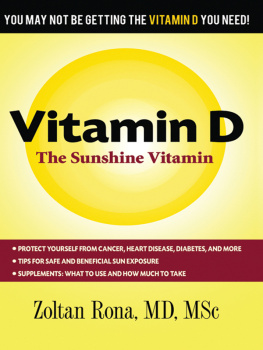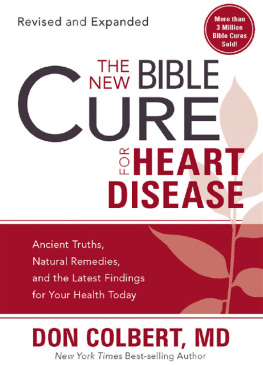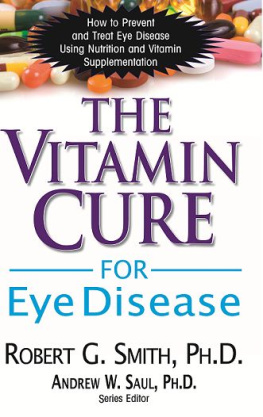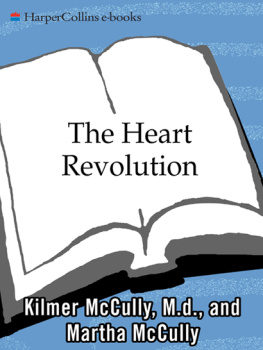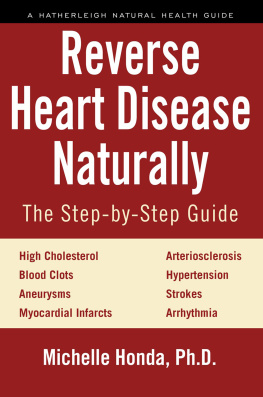Hilary Roberts - The Vitamin Cure for Heart Disease
Here you can read online Hilary Roberts - The Vitamin Cure for Heart Disease full text of the book (entire story) in english for free. Download pdf and epub, get meaning, cover and reviews about this ebook. year: 2011, publisher: Basic Health Publications, genre: Science. Description of the work, (preface) as well as reviews are available. Best literature library LitArk.com created for fans of good reading and offers a wide selection of genres:
Romance novel
Science fiction
Adventure
Detective
Science
History
Home and family
Prose
Art
Politics
Computer
Non-fiction
Religion
Business
Children
Humor
Choose a favorite category and find really read worthwhile books. Enjoy immersion in the world of imagination, feel the emotions of the characters or learn something new for yourself, make an fascinating discovery.
- Book:The Vitamin Cure for Heart Disease
- Author:
- Publisher:Basic Health Publications
- Genre:
- Year:2011
- Rating:5 / 5
- Favourites:Add to favourites
- Your mark:
- 100
- 1
- 2
- 3
- 4
- 5
The Vitamin Cure for Heart Disease: summary, description and annotation
We offer to read an annotation, description, summary or preface (depends on what the author of the book "The Vitamin Cure for Heart Disease" wrote himself). If you haven't found the necessary information about the book — write in the comments, we will try to find it.
Readers learn to take charge of their own heart health with safe and effective therapies.
The Vitamin Cure for Heart Disease — read online for free the complete book (whole text) full work
Below is the text of the book, divided by pages. System saving the place of the last page read, allows you to conveniently read the book "The Vitamin Cure for Heart Disease" online for free, without having to search again every time where you left off. Put a bookmark, and you can go to the page where you finished reading at any time.
Font size:
Interval:
Bookmark:
ACKNOWLEDGMENTS
We would like to thank all those who have encouraged us in this work. Dr. Abram Hoffer helped create a better understanding of nutritional medicine. On this side of the Atlantic, Dr. Damien Downing, of the British Society for Ecological Medicine, has been equally helpful. Gert Schuitemaker and Elsedien de Groot have strived tirelessly to promote orthomolecular medicine in Europe. We have also welcomed the support of Dr. Atsuo Yanagisawa, a pioneer of the use of vitamin C therapy in Japan.
Bill Sardi sends frequent emails detailing developments in orthomolecular medicine, particularly vitamin C. He shows a high degree of sophistication in selecting critical papers of interest. Owen Fonorow and the Vitamin C Foundation have kept Linus Paulings work on vitamin C and heart disease in the public eye. A stimulus for our work has been discussions with Dr. Michael Gonzales and Dr. Jorge Miranda-Massari. We would like to thank Hilarys father, Michael Roberts, a retired consultant surgeon, who discussed the conventional viewpoint with us. We are also grateful to Fiona Roberts, and to Eileen and George Fondis, for the generous loan of their computers. The macrophage cartoon is copyright by Dr Mikael Nicu of the University of Helsinki reproduced with permission.
In particular, we would like to thank Dr. Jim Jackson for his outstanding work in nutrition. His research has changed the way nutrients are viewed by the current generation of scientists.
ABOUT THE AUTHORS
Hilary Roberts doctoral research on the effects of early-life under-nutrition was carried out in the Department of Child Health at the University of Manchester, England. She is co-author, with Steve Hickey, of Ascorbate: The Science of Vitamin C, Cancer: Nutrition and Survival, Ridiculous Dietary Allowance, and The Cancer Breakthrough.
Steve Hickey received his doctorate in Medical Biophysics from the University of Manchester, England. He is a member of the Institute of Biology (Pharmacology), a Chartered Biologist, and a former member of the British Computer Society. He has published over 100 scientific papers and is the author of The Vitamin Cure for Migraines (Basic Health, 2010) and other books on science and health.
CHAPTER 1
THE NUMBER ONE KILLER
A great doctor kills more people than a great general.
GOTTFRIED WILHELM LEIBNIZ (16461716)
T his book is about heart disease and related conditions, such as vascular disease, stroke, and diabetes. It explains the cause of the disease and how to keep your cardiovascular system healthy. Currently, people with heart disease are told there is no cure, and that their only choices are surgery and long-term treatment with drugs. This book provides another option. Atherosclerosis, the ultimate cause of most cardiovascular disease, is both preventable and reversible. We explain how simple supplements can prevent the disease and return a sufferer to good health.
Despite millions of dollars spent on research, heart disease remains one of the main causes of death in the Western world. Around the world, about three in ten people (29 percent) die of cardiovascular disease. Slightly more people die from heart disease than from stroke: heart disease is the single biggest killer in the West, with stroke in third place. One in eight adults in the United States has been diagnosed with heart disease. On average, one American dies of cardiovascular disease every minute, so someone in the U.S. has probably succumbed to the disease since you started reading this chapter.
People are so used to this situation that perhaps heart disease seems inevitable, but it is not. The epidemic of heart disease is a modern phenomenon. We have written this book for people who want to reduce their risk of becoming a heart disease statistic. In particular, the book focuses on alternatives to conventional approaches for prevention and treatment of these disorders, including dietary changes and food supplements. In order to understand how these might work, we first describe the development of cardiovascular disease and how this is influenced by nutritional and lifestyle choices.
Awareness of the disease mechanisms suggests methods for direct intervention and prevention. Prevailing ideas on heart disease are often misguided, so what you read may surprise you. For example, experts attribute the disease to risk factors, which have become part of popular culture. Cardiologists assert that we now have overwhelming evidence that high cholesterol causes coronary disease. Such multi-factorial explanations are a way of disguising ignorance. We are interested in direct causative explanations, not loose statistical associations.
This book explains the underlying causes of atherosclerosis and its deadly results, including heart attack, stroke, and aneurism. Cardiovascular diseases are caused by inflammation and oxidation in the walls of arteries; this has been known for decades, but conventional medicine has apparently failed to understand the implications of this fact. The myths have entered popular culturea television soap opera character warns against the dangers of cholesterol, while snatching a delicious bacon and egg breakfast from under the nose of a crestfallen victim. In the popular imagination, though rarely discouraged by the medical profession, this is entirely appropriate, because viewers believe that cholesterol causes heart disease. As we shall see, the evidence does not support this simplistic idea. To understand a problem, it is important to approach it with an open mind. This can be hard, when misinformation floods the media. Despite popular impressions, risk factors do not explain heart disease: the links between them and the cause of disease are tenuous. To find out what is really going on, we need to get back to basics.
One reason for medicines failure is increasing specialization, as doctors and researchers learn more and more about less and less. Thousands of research papers are published which require the specialist expertise of a particular discipline to appreciate their full meaning. However, medical scientists rarely have the time to trawl through papers extending back over decades; it is hard enough to keep up with developments in just one field. Over-specialization can mean that underlying mechanisms remain unappreciated for long periods. To take an analogy, suppose motor mechanics were to specialize. An autoelectrologist would be great if you had a faulty light or a dead battery, but not if your car was leaking brake fluid or had run out of gas!
The proliferation of heart and vascular disease is a relatively recent phenomenon. Until the last century, the condition was rare, which leads us to question why so many more people are now dying from heart disease or stroke. Fortunately, the information needed to eliminate these killers is available, if we are prepared to look for it.
WHAT CAUSES HEART DISEASE?
Atherosclerosis is a disease that thickens blood vessel walls. The term arteriosclerosis is sometimes used interchangeably with atherosclerosis, but more often refers specifically to stiffening of the arteries. During the development of atherosclerosis, damage to the artery wall leads to localized areas of inflammation, called plaques, which can be either stable or unstable.
Stable plaques are relatively safe. They grow slowly and although they may block an artery completely, this is rare. Unstable plaques are more dangerous. These plaques are active: they can grow rapidly or they may fade and return to being relatively healthy tissue. Active plaques have a thin, fibrous cap, covering a soft core that contains fat and white blood cells. The cap helps strengthen and enclose the plaque, increasing its stability. Despite this, plaques can become acutely inflamed, causing the fibrous cover to split open. Plaques are similar to skin pimples, which can flare up and burst at any time or may quietly fade back, leaving unblemished skin.
Next pageFont size:
Interval:
Bookmark:
Similar books «The Vitamin Cure for Heart Disease»
Look at similar books to The Vitamin Cure for Heart Disease. We have selected literature similar in name and meaning in the hope of providing readers with more options to find new, interesting, not yet read works.
Discussion, reviews of the book The Vitamin Cure for Heart Disease and just readers' own opinions. Leave your comments, write what you think about the work, its meaning or the main characters. Specify what exactly you liked and what you didn't like, and why you think so.

